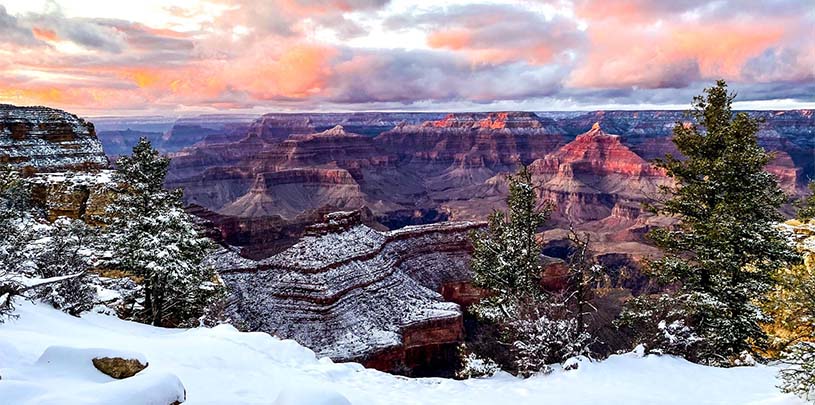
by Amber Reimondo, Energy Director
Is 2022 the year of banning new uranium mines around the Grand Canyon forever? We sure hope so.
As the country heads into the second year of the 117th Congress and the Biden administration with the Grand Canyon Protection Act yet to become law, we’re reflecting on how far we’ve come and what still needs to happen in 2022 for a permanent mining ban to finally become reality.
The work to protect the Grand Canyon region and its precious waters from uranium mining has taken a variety of forms over the years as tribes, congressional allies, nongovernmental organizations like the Grand Canyon Trust, and community members and leaders have adapted to the ebb and flow of political circumstances, opportunities, and threats.
Today, the bill to protect the Grand Canyon is called the Grand Canyon Protection Act. It would permanently ban new uranium mines on about a million acres of federal land around the Grand Canyon.
A complex groundwater system connects these lands to the Grand Canyon. In a landscape of fractured rock, how far and how fast water flows, and the paths it follows before emerging into the Grand Canyon as seeps or springs, are still not well understood.
The substance of what is now the Grand Canyon Protection Act was first introduced in the 110th Congress in 2008 by Arizona Congressman Raúl Grijalva and originally called the Grand Canyon Watersheds Protection Act. Between 2008 and 2013, the Grand Canyon Watersheds Protection Act was introduced four times and had as many hearings, but died each time before even getting a vote in the House, let alone seeing daylight in the Senate.
In 2012, after much work by tribes, Rep. Grijalva, community leaders, the Trust, and our partners, the secretary of the interior declared a temporary administrative mining ban on the same area near the Grand Canyon. But in 2016, President Obama ultimately declined to use his executive authority under the Antiquities Act to establish a national monument in the region, which would have included a permanent mining ban.
In February 2019, at the start of the 116th Congress, Rep. Grijalva introduced the legislative permanent mining ban again, this time called the Grand Canyon Centennial Protection Act, in honor of Grand Canyon National Park’s centennial that year. The bill passed the House, and was introduced in the Senate by Arizona Sen. Kyrsten Sinema. But there it stalled and died before it could face a vote on the Senate floor.
Remember, a bill must pass both chambers of Congress and be signed by the president in order to become law. If one chamber fails to vote, or votes “no,” the bill dies.
In February 2021, at the start of the 117th Congress, Rep. Grijalva reintroduced the current bill to permanently protect the Grand Canyon from mining – the Grand Canyon Protection Act. Arizona senators Kyrsten Sinema and Mark Kelly weren’t far behind, introducing their version of the bill in the Senate a week later. The House quickly passed the bill as part of a larger public lands package. But, like the previous year, things slowed way down in the Senate.
ABOUT THE BILLS
H.B. 1052, the House version of the Grand Canyon Protection Act ›
S. 387, the Senate version of the Grand Canyon Protection Act ›
At one point, the bill was added as an amendment to the House version of a defense spending bill called the National Defense Authorization Act and it passed the House for a second time in 2021. Unfortunately, the Senate didn’t include the Grand Canyon Protection Act in its version of the defense spending building. Although senators Sinema and Kelly requested that the Grand Canyon bill be included as an amendment to the Senate version of the spending package, it was ultimately not included in the version that reached President Biden’s desk.
Anyone following Congress over the past year knows that things are complicated. Other important priorities like the bipartisan infrastructure bill and voter rights legislation have occupied center stage. But we also know that the effort to protect the Grand Canyon from new uranium mines has come a long way since 2008 and one way or another, together, we will win permanent protection for this region.
2022 is the last year of the 117th Congress. If the bill doesn’t pass the Senate, the Grand Canyon Protection Act will die yet again. In order to have another chance at becoming law, the process of House and Senate bill introductions, committee hearings, and floor votes would have to start all over again in 2023.
In 2022, we need the Grand Canyon Protection Act to be scheduled for a hearing before, and to pass out of, the Senate Energy and Natural Resources Committee, of which the bill’s co-sponsor, Sen. Kelly, is a member. We then need senators Sinema and Kelly to seize any and every opportunity to pass the Grand Canyon Protection Act out of the Senate so that it may finally, after more than a decade of work, be signed into law by President Biden.
Please take a moment to thank senators Sinema and Kelly for their work thus far, and urge them to keep pushing. If you live outside Arizona, please urge your senators to support permanent protection for the Grand Canyon.
Act now. Urge your senators to support, co-sponsor, and push for a committee hearing for S. 387, the Grand Canyon Protection Act, to permanently ban new uranium mines on public lands around the Grand Canyon.
A small victory in the legal case challenging Daneros uranium mine, near Bears Ears National Monument.
Read MoreGroundwater pumping at a uranium mine near the Grand Canyon will affect the canyon's springs, scientists says.
Read MoreA rally in Salt Lake City followed by a spiritual walk in White Mesa demonstrate the Ute community's determination to see uranium mill close.
Read More